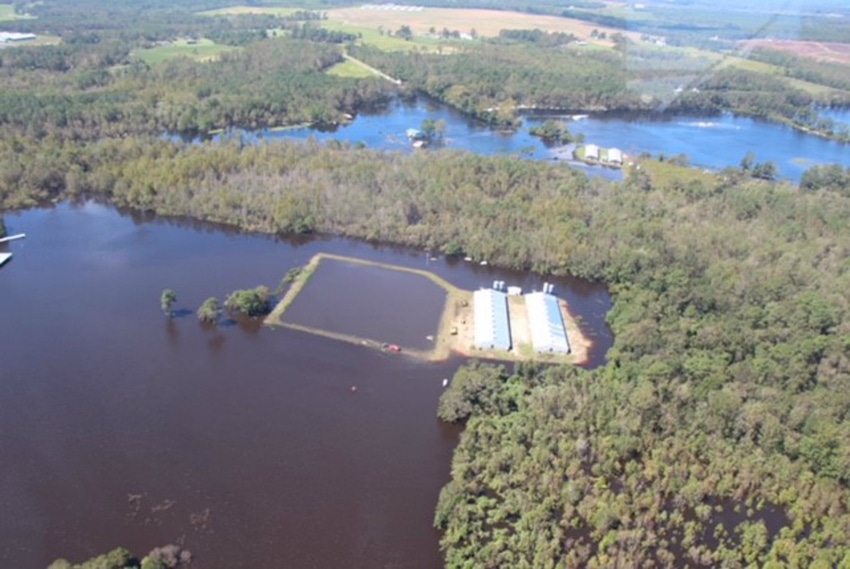North Carolina swine producers stand up to Mother Nature
Having an action plan in the event that severe weather effects your operation will have you prepared for whatever Mother Nature throws your way.
December 13, 2018

By Jonathan Holt, North Carolina State University
North Carolina swine producers have experienced plenty of weather-related problems in the fall of 2018. Hurricane Florence, which hit the state in mid-September, resulted in record levels of flooding in much of North Carolina. Less than a month later in October, the remnants of Hurricane Michael swept through parts of the state dropping more rain and high winds.
Now this week in December, North Carolina is dealing with cold temperatures and unprecedented snow. Many counties in the state recorded a year’s average of snow fall in just one day, creating a whole new set of weather-related issues. Swine producers in North Carolina have taken extraordinary measures to provide animal care before, during and after these storms.
Weather events such as these often leave unexpected issues, but being prepared can make a huge difference. As producers get back to normal operations after the storms, it’s important to assess the following factors in and around swine facilities to provide proper well-being of the animals. While North Carolina producers are dealing with flood recovery, the suggestions given are applicable during any natural disaster which may occur.
Inventory all animals
As soon as possible after a storm, attempt to inventory all animals and locate any missing animals. Inform neighbors and other producers about lost animals. If you find any displaced animals that are not yours, attempt to pen those animals in an area away from your own stock. You cannot be sure of disease status of other herds. It is also important to move any mortalities away from live animals as quickly as possible to prevent potential disease spread.
Repair or remove damaged equipment
Building structures as well as feed bins, augers, feeders, crates, etc., should be inspected for damage. Damaged equipment can result in cuts and other injuries to pigs, as well as people. It is important that everyone stays safe in the facility while working. This is also a good time to check that water nipples are flowing correctly and that any wet feed is removed from feeders and proper adjustments are made for feed flow.
Take into consideration that some pigs may have been restricted from feed during the weather event and co-mingling in new pens will change feeding behavior. It may be useful to open feeder adjustments to account for increased meals in the days following a storm.
Observe all animals for wounds and health
All pigs should be visually inspected, and any wounds should be treated immediately. This may include euthanasia for severe injuries that cannot be treated. Pigs needing treatment should be isolated into treatment pens away from the rest of the population. Pay close attention to the pigs’ hooves, especially breeding animals. Prolonged exposure to standing water and wet environments can increase infections of the foot and damage to the hoof.
Lastly, if dealing with flooding, it may be necessary to increase the amount of fly traps and repellents as it is common to see increased insect activity after flooding occurs.
Inspect feed and water
Wet feed and water-damaged grain can become moldy and cause digestive problems. Mold can also lead to problems associated with mycotoxins. Furthermore, feed and grain that has been subjected to flooding could be contaminated with other harmful chemicals. Pigs should not be forced to consume potentially contaminated feeds. Observe the pigs and if feed refusal is noticed, the feed should be replaced.
Severe flooding can also contaminate the water supply used for your pigs with chemicals or harmful bacteria. It is important to observe pigs for gastrointestinal issues that may be associated with contaminated water and have your water tested if a problem is suspected.
As winter is now upon us, here are a few more considerations when raising swine in colder weather.
Check buildings for any cracks or openings and repair anything that creates a draft
Clean ventilation fans and make sure all are working properly
Ensure thermostats are set correctly and adjust if necessary
Check heaters for gas supply and potential leaks
Protect water lines from freezing temperatures
Increase rodent control as decreased temperatures tend to bring them indoors
Adjust feed rations or amount of feed offered as pigs eat more in cold weather
Following these suggestions and having an action plan in the event that severe weather effects your operation will have you prepared for whatever Mother Nature decides to throw at you.
You May Also Like



